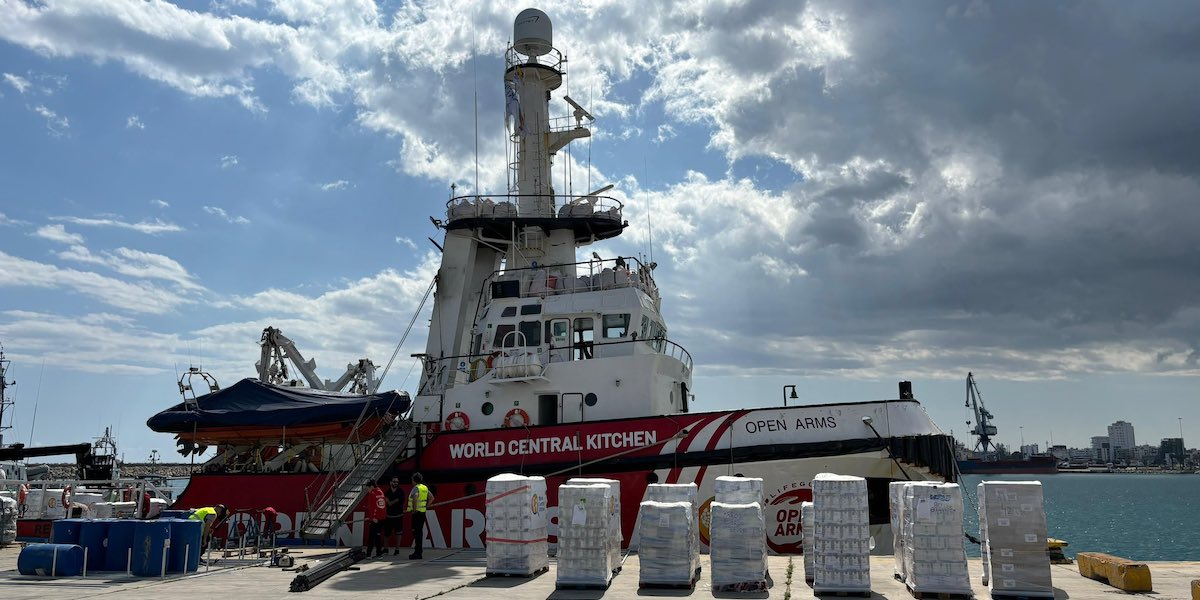Loading player
Between Thursday and Friday, both the United States and the European Union separately announced plans to deliver humanitarian aid by sea to the Gaza Strip, where the Palestinian civilian population is suffering a dire shortage of basic necessities due to the ongoing war. since October between Israel and the radical Palestinian group Hamas, which governs the Strip. The first aid ship could leave between Saturday and Sunday, although at the moment it is not known exactly when and there are still many aspects to be clarified on how the aid will be disembarked and distributed.
US President Joe Biden said on Thursday that the US military will build a temporary pier on the coast of the Strip to facilitate the arrival of aid by sea; On Friday, the President of the European Commission Ursula von der Leyen announced that a “maritime corridor” would be activated starting this weekend to bring aid to the Strip by sea, with ships leaving from Cyprus.
It has not been explicitly said whether the two plans are connected, but it is already known that the United States is among the countries that will participate in the humanitarian corridor announced by von der Leyen, together with Italy, Germany, Greece, the Netherlands, the United Kingdom, the Emirates United Arab Emirates and Cyprus itself. The ships in the maritime corridor will depart from the port of Larnaca in south-eastern Cyprus, which is also where von der Leyen announced the new way of delivering aid on Friday.
The first ship that should test the route is already almost ready: it is owned by the Spanish NGO Open Arms and will transport food from the World Central Kitchen, a humanitarian organization founded by the well-known Spanish-American chef José Andrés . Several sources had already reported that the ship could leave over the weekend, and on Friday Andrés himself published several images on his social profiles showing the preparation of the ship, saying that the mission started with Open Arms “is finally in the final stages” . Andrés said the ship will bring 200 pallets of humanitarian aid “to the beaches of Gaza”.
.@WCKitchen has a simple motto: Feed the hungry yesterday. Don’t plan, adapt! People of North Gaza are desperate. Now a weeks old plan with @openarms_found in finally in the final stages. To land in the beaches of Gaza with 200 pallets. And to do it everyday, increasing the… pic.twitter.com/QmUxEFYMLY
— José Andrés 🇺🇸🇪🇸🇺🇦 (@chefjoseandres) March 8, 2024
There are still many aspects to be clarified. For example, it is not known where the ship should disembark and how the aid will then be distributed: already in recent weeks distribution has been very complicated within the Strip, and humanitarian convoys have been attacked several times by desperate people who have taken away the cargo , armed with pistols or other makeshift weapons.
To make the corridor work, Israel’s collaboration will also be necessary, which is not a given because in recent months the government and the army have in various ways limited and hindered humanitarian assistance in the Strip, above all by imposing lengthy checks on each convoy. Israel has already said that it is in favor of the “maritime corridor”, but that the usual controls will be necessary on that aid too.
Aside from the first Open Arms ship, it is likely that it will take time to get the humanitarian corridor up and running, and reaching a certain frequency of aid shipments will have to wait for the construction of the dock by the United States. However, there are several problems with this too, starting with the time it will take to achieve it: it could take weeks (or even a few months, American officials said), but the situation in Gaza is so serious that the need for aid is immediate.
Several humanitarian organizations have criticized these plans, arguing that the quickest and safest way to get as much aid as possible is always by truck, and that in this way Israel’s obstructionism is supported rather than trying to force it. In a statement on Friday, the NGO Doctors Without Borders defined the US pier plan as “an obvious distraction”, arguing that the problem of getting the aid delivered is not a logistical one, but a political one (i.e. that there is no need to get it in different ways, but only convince Israel to let them in and distribute them safely).
The other method tested so far to get aid in, the one with parachutes, is also having problems: on Friday the government of the Strip announced that five people were killed by a load that had been parachuted, after a parachute failed it had opened regularly.
